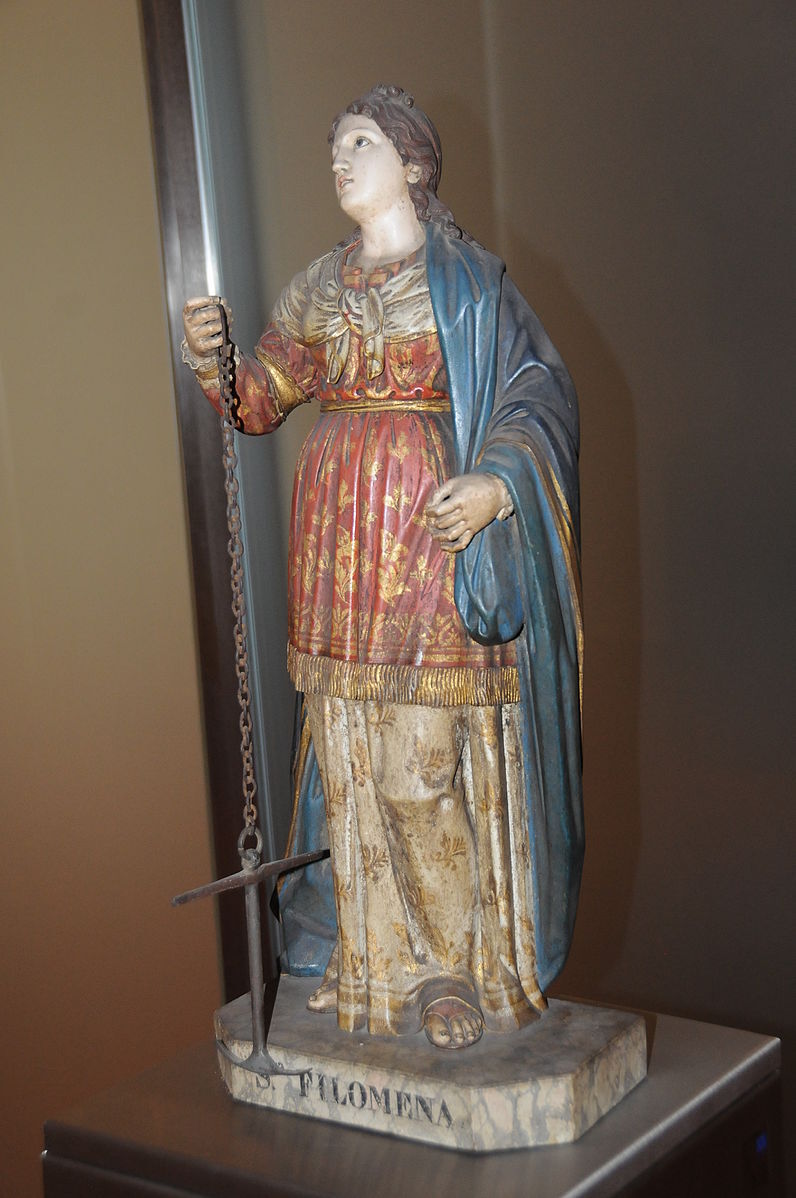Sculptor paints a corpse face on the statue of Saint Philomena and supernatural hands redo the painting giving it an angelical appearance

The miracle reported below is a translation of the text obtained from the website of the National Shrine of Saint Philomena, in Briggsville Wisconsin, in the United States (The National Shrine of Saint Philomena ) and approved by church authorities, bishops and some Popes.

Source: Google Maps Images
The request to build the statue of Saint Philomena
"In June 1925, Mrs. Maria Cementano , accompanied by her friend Maria Compare, went to the studio of the famous artist Louis De Luca and, with sincere and courageous words, exposed her fervent desire for an image of Saint Filomena to the Church of Cesárea. It was to be made of papier- mâché and the artist had to create only the hands, head and feet, as the young devotee wanted to dress the saint personally in a white dress and a purple cloak.
At first he refused, claiming that he was a famous artist and was used to making his artistic forms in bronze and marble, not papier- mâché. He wanted to give full expression and life to his works. He didn't just make mutilated heads and stumps of saints. Later, convinced by the young woman's insistence, he accepted.
He fell in love with the subject; He lived that period (...) in the intimacy of his heart and completed the statue, which was presented on August 13, 1925. A few days later, De Luca was no longer happy with his work. While everyone praised her, he felt the need to correct her . For an entire month he revived his Saint Philomena and only on September 30th was the statue returned to the Sanctuary of Caesarea.
Dissatisfaction with the painting of the image
The first of October was, then, the important vigil (...)
but the people would not recognize their Saint in this statue, because De Luca decided to represent a dying young woman, giving the image a cadaverous look. The eyelids down, the lips a purplish color. This statue represented a dying person, perhaps a heroine, but certainly not a martyr. There was no rosy glow on that face, no trace of a mystical passion.
The reason the statue had "no life" was simple: the artist had no spiritual sensitivity. Dom Fabozzi tried to explain to De Luca that Saint Philomena was a martyr and that martyrs, in the supreme moment, become luminous , inflamed with love for God; They are never more alive than at the moment they die.
De Luca didn't want to hear any of it. The barrier between them was not about a different concept of art, but a different concept of faith.
The work was temporarily placed in the sacristy. During that day she was seen by many priests, nuns, charitable ladies and they all shared the same opinion: she was friendly, she was beautiful, but she looked like a corpse. The same girls who had commissioned the statue were unhappy and tried to convince the artist to color it a little, but when they learned that this would require more time, they decided to leave it as it was. Disappointed, they asked De Luca to personally place the purple cloak artistically on the statue.
The miraculous supernatural painting redone on the statue
The following day, October 2, was the feast of the Angels, and Dom Fabozzi celebrated mass in their honor, where there was an altar dedicated to them. When Father Di Millo, who was to celebrate the next mass, arrived, he did not think it convenient to put on his clothes in the sacristy during the celebration (...) and, contrary to his usual behavior, he went to the last room (where the image was).
Driven by curiosity, he lifted the newspapers that covered the statue and he too was impressed by that deadly color. A short time later, De Luca entered (in the same room) and suddenly came out very agitated, trembling, emotional. Turning to Dom Fabozzi, he asked who had modified the statue.
The priest told him that no one had retouched it, but seeing that he was not convinced, they both went to the last room.
He was also stunned. The image was no longer the same. The features remained the same, but over them an unknown hand spread an extremely delicate pink tone. It was subtle, virginal pink. The color was not uniform, only on the cheeks, nostrils, and chin... even under the nails there was this amazing shading.
They were not patches, but admirably artistic. Particularly surprising were the lips: the purplish color had disappeared, and now there was a pinkish color that was not uniform, but full of different shades. The statue was completely dry, as if it had been painted more than a fortnight before. In fact, the hair that De Luca had put in the previous week was still "sticky", while the face, painted now by a mysterious brush, was completely dry.
They tried to give little publicity to the event because they wanted to study the surprising phenomenon.
Tests to prove the miracle
In the newspaper Roma, there was an article that suggested a test to verify the miracle. If De Luca still had leftover colors used for the statue, why not paint a head, place it in the same environmental conditions, and then check after a few days to see what happened?
The experiment was immediately accepted and carried out to scientific standards. The head of a statue was painted with what was left of the colors used by De Luca, using the utmost caution. A few days later, the seals were removed and the result was verified: the head remained yellowish, pale, cadaverous.
At this point, someone talked about a chemical reaction. De Luca was questioned and asked what materials he had used for the painting. He stated that he had used yellow clay and silver grout, adding some amber and some green clay. By mixing the yellow clay with the sombre silver grout, he had achieved a pale, almost deathly color. He gave the work three coats of this paint, leaving a few days between each to allow them (...) to dry properly. With such technical and chemical elements it was impossible to have such an anomalous reaction to generate a pink color. What had happened was supernatural!
In fact, the members of the Artistic Club of Naples sent a report to the Ecclesiastical Authorities, signed by the Court of Inquiry, in which it was declared that, in those environmental conditions, a chemical reaction could not have produced the known phenomenon.
These were very brave people, it must be admitted, because asserting the truth in a century permeated by skeptics was a true act of courage."
References: The Nacional Shrine of Saint Philomena, Google Maps